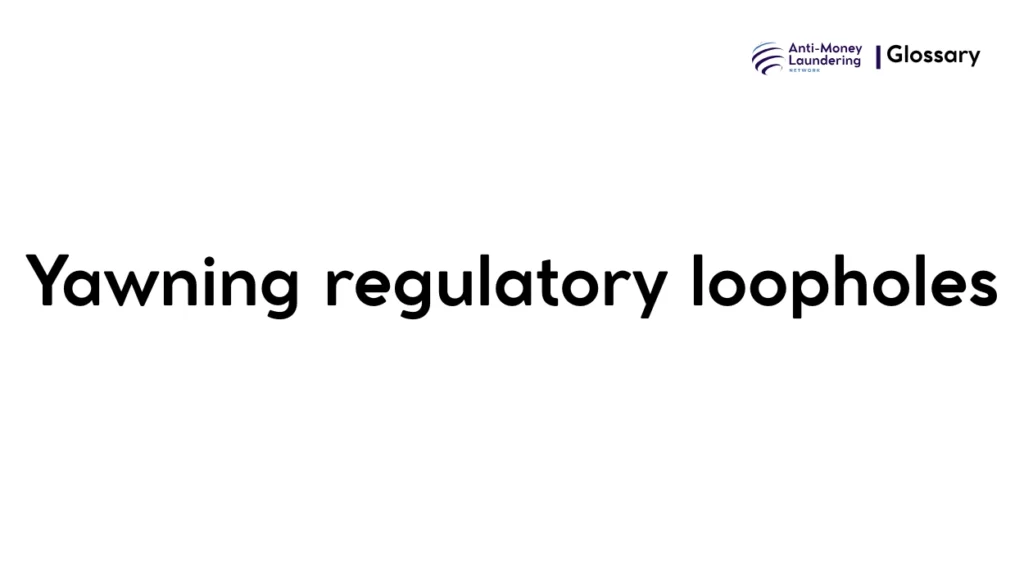Definition
“Yawning regulatory loopholes” in Anti-Money Laundering (AML) refer to significant and glaring gaps or deficiencies within AML laws, regulations, supervisory frameworks, or enforcement mechanisms that allow criminals to exploit vulnerabilities to move, disguise, or integrate illicit proceeds with minimal risk of detection or penalty. These loopholes create weak spots in the AML system where illicit financial flows can bypass compliance controls, undermining the effectiveness of global and national anti-money laundering efforts.
Purpose and Regulatory Basis
The purpose of identifying and closing yawning regulatory loopholes is to strengthen the integrity of the financial system and prevent it from being misused for money laundering or terrorist financing. AML regulations such as those framed by the Financial Action Task Force (FATF), USA PATRIOT Act, and European Union AML Directives (AMLD) seek to establish comprehensive controls to detect and deter financial crime. These regulations require institutions to perform customer due diligence, transaction monitoring, suspicious activity reporting, and maintain robust internal controls. However, where laws are ambiguous, outdated, or enforcement inconsistent, yawning loopholes emerge, threatening the AML regime’s overall efficacy.
When and How It Applies
Yawning regulatory loopholes become critical in scenarios where:
- Emerging financial products or technologies like cryptocurrencies are insufficiently regulated.
- Jurisdictions have weak AML laws or lax enforcement.
- Complex corporate structures shield beneficial ownership.
- Cross-border cooperation between regulators is limited or ineffective.
Examples include inadequate oversight of shell companies, limited due diligence on politically exposed persons (PEPs), and insufficient monitoring of non-traditional financial service providers. Criminals exploit these vulnerabilities to place, layer, and integrate illicit funds into the financial system with relative ease.
Types or Variants
Various forms of yawning regulatory loopholes can exist, such as:
- Legal Loopholes: Gaps or ambiguities in AML laws or regulations.
- Enforcement Loopholes: Weaknesses in supervisory and enforcement actions.
- Technological Loopholes: Lack of regulation in new technologies (e.g., virtual assets).
- Inter-jurisdictional Loopholes: Differences in AML standards or cooperation failures between countries.
For example, jurisdictions with incomplete beneficial ownership registries create legal loopholes, while inconsistent transaction monitoring regimes reflect enforcement loopholes.
Procedures and Implementation
To comply and address yawning regulatory loopholes, financial institutions must:
- Conduct comprehensive risk assessments to identify areas vulnerable to exploitation.
- Implement enhanced due diligence (EDD) for higher-risk customers and transactions.
- Maintain up-to-date AML policies reflecting evolving regulatory expectations and emerging threats.
- Use advanced technologies like AI for transaction monitoring and anomaly detection.
- Engage in ongoing training programs to ensure staff awareness.
- Cooperate actively with regulators and law enforcement to close gaps collectively.
Impact on Customers/Clients
From the customer perspective, addressing regulatory loopholes involves:
- More rigorous identification and verification procedures.
- Enhanced scrutiny of transactions, especially for higher-risk clients.
- Potential delays in onboarding or transaction approvals due to increased checks.
While these measures may impose more stringent controls, they are vital to safeguard the financial system and the legitimate interests of all clients.
Duration, Review, and Resolution
Yawning loopholes require continuous monitoring and timely resolution. Regulatory frameworks often mandate periodic reviews of AML programs and controls to assess effectiveness and identify weaknesses. Institutions must document these reviews, rectify identified gaps, and remain alert to new risks evolving from financial innovation or regulatory changes.
Reporting and Compliance Duties
Institutions are obligated to:
- Report suspicious transactions promptly to Financial Intelligence Units (FIUs).
- Maintain thorough records demonstrating compliance efforts.
- Cooperate with regulatory audits and investigations.
Failure to do so can result in severe penalties, including fines, restrictions, and reputational damage.
Related AML Terms
Yawning regulatory loopholes relate closely to:
- Risk-Based Approach (RBA): Identifying and prioritizing risks to close vulnerabilities.
- Beneficial Ownership Transparency: Preventing misuse of anonymous ownership.
- Customer Due Diligence (CDD) and Enhanced Due Diligence (EDD): Tools to detect and mitigate risks.
- Suspicious Activity Reporting (SAR): Mechanism for flagging suspicious transactions.
- Know Your Customer (KYC): Foundation of customer identification.
Challenges and Best Practices
Challenges include rapidly evolving financial technologies, jurisdictional arbitrage, and inconsistent regulatory frameworks. Best practices involve:
- Regular regulatory updates and staff training.
- Leveraging technology for real-time monitoring.
- Proactive cooperation with global AML initiatives.
- Enhancing transparency in ownership and transactions.
- Holistic organizational commitment to AML culture.
Recent Developments
Recent trends focus on:
- Strengthening regulations on cryptocurrencies and virtual assets.
- Improving global AML cooperation through FATF updates.
- Implementation of beneficial ownership registries.
- Utilizing artificial intelligence and big data analytics.
- Increasing sanctions enforcement overlapping with AML.
Yawning regulatory loopholes represent significant vulnerabilities in anti-money laundering frameworks that undermine the fight against financial crime. Closing these gaps through robust regulatory measures, advanced compliance programs, and international cooperation is essential to protect the financial system’s integrity and support global efforts against money laundering and terrorist financing.

